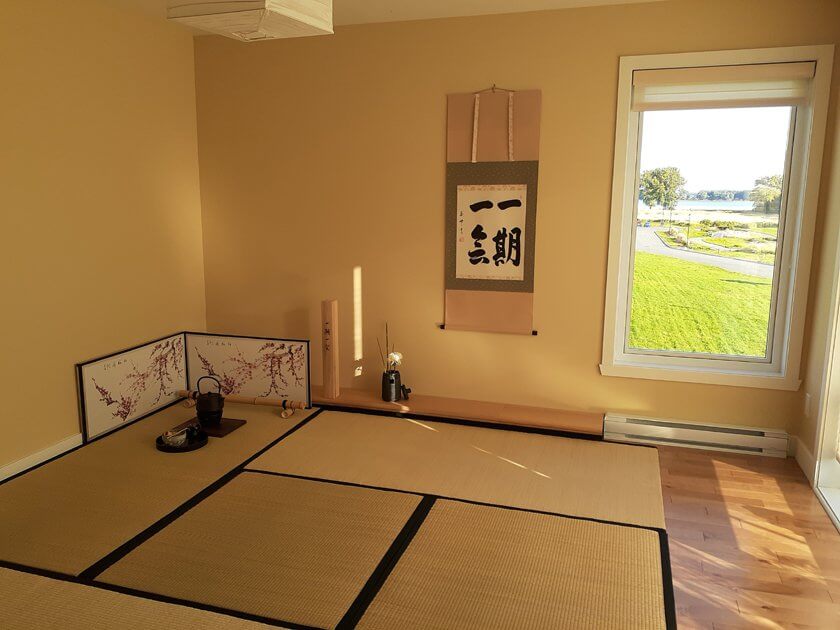Kakejiku is an Essential Item for Chashitsu/Tearoom.

The Japanese tea ceremony is a Japanese tradition that has a history of over 500 years. A trial lesson of tea ceremony for foreign tourists has been around for many years. But it has more recently surged in popularity because many shops/tea houses now offer an English Chado workshop. Participating in a tea ceremony is a perfect way to deepen your understanding of Japanese culture. Also, some tea schools conduct an English Chado workshop in the world and as a result, the number of people practicing Chado in earnest is getting larger in the past years.
Today, we are going to talk about our recent business with a gentleman who practices Chado in Canada.
Following is a kakejiku he purchased. Calligraphy reads “一期一会/Ichi-go Ichi-e”.

Ichi-go ichi-e (lit. “one time, one meeting”) is a Japanese four-character idiom (yojijukugo) that describes a cultural concept of treasuring meetings with people. The term is often translated as “for this time only,” “never again,” or “one chance in a lifetime.” The term reminds people to cherish any gathering that they may take part in, citing the fact that many meetings in life are not repeated. Even when the same group of people can get together again, a particular gathering will never be replicated, and thus, each moment is always once-in-a-lifetime. The concept is most commonly associated with Japanese tea ceremonies, especially tea masters Sen no Rikyū and Ii Naosuke. The death was closer to people in the Sengoku period (c. 1467 – c. 1603), when tea ceremony culture reached full bloom, than the present day. Therefore, it is considered then that the concept of Ichi-go ichi-e was born.
There is a concept of “Mujō”, which is considered to be a fundamental concept of Buddhism, in Japanese aesthetic senses. The word “mujō” expresses the idea that all beings in the phenomenal world do not abide, but disintegrate and are in constant transition. The Japanese people love cherry blossoms because they are not permanent and give a feeling of mujō (transience). While Westerners seek beauty in “eternal beings,” many Japanese have a strong tendency to seek beauty in phenomena that are constantly transforming. Mujō can be regarded as the unique characteristic of the Japanese concept of beauty that has been growing since the medieval era.
The word “Ichi-go ichi-e” was born from the aesthetic sense. It is often brushed onto scrolls that are hung in the tea room.
The customer has shared with us a picture of the mentioned scroll displayed in his room. Just wow…!

The picture was breathtaking. We couldn’t take our eyes off the picture for a while. The atmosphere of the room here is close to authentic Japanese tearoom. We rarely see Japanese people who have such a great tearoom/chashitsu like this in modern days. The kakejiku, tea utensils, and surrounding objects are in perfect harmony.
The customer told us a story of how he bought the kakejiku.
For your information, the arrangement of my chasitsu is not used for decorative purposes. To make a short summary of my interest in tea ceremonies, I followed last fall and winter, while I was living in Quebec City, Chanoyu classes given by the Chado Urasenke Tankokai of Quebec City, which is a subsidiary of the Urasenke School in Kyoto. I want to continue putting into practice what I have learned and having a chasitsu brings the appropriate general mood to make temae.
And kekejiku is an important element to bring this mood…
The customer also liked a paulownia wooden box of the scroll and displayed it in his chashitsu. Please see a standing box right next to the small byobu (folding screen) in the above picture.
The packaging itself was worthy of mention. It was the work of art I was missing to complete the development of my chasitsu.
We are glad that he was happy with his purchase and our product helped complete his tearoom/chashitsu.
If you are looking for a hanging scroll with Zen words for your chashitsu, please feel free to contact us. We will always be happy to assist you.









